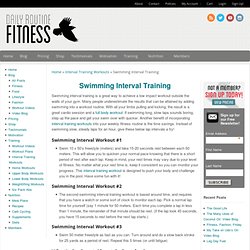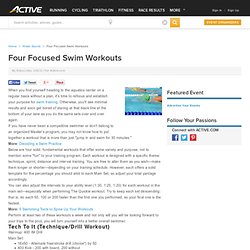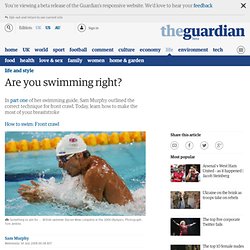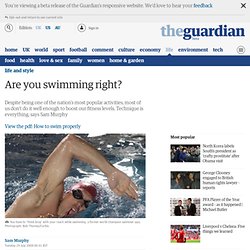

Swimming Interval Training - Daily Routine Fitness. Swimming interval training is a great way to achieve a low impact workout outside the walls of your gym.

Many people underestimate the results that can be attained by adding swimming into a workout routine. With all your limbs pulling and kicking, the result is a great cardio session and a full body workout. If swimming long, slow laps sounds boring, step up the pace and get your swim over with quicker. Another benefit of incorporating interval training workouts into your weekly fitness routine is the time savings. Instead of swimming slow, steady laps for an hour, give these below lap intervals a try! Swimming Interval Workout #1 Swim 10 x 50’s freestyle (meters) and take 15-20 seconds rest between each 50 meters.
LAP SWIMMERS, TRY AN INTERVAL WORKOUT FOR YOUR NEXT WORKOUT. If you are a lap swimmer churning up the yards, we have a great booster for your regular swimming agenda: interval training.

Interval training will maximize your time in the water and help you to achieve new heights in your swimming abilities with increased conditioning and better form. In a busy adult world time is essential. Use it all to the fullest. Try our coached-designed workout program every other workout for your next twenty workouts. Four Focused Swim Workouts. When you find yourself heading to the aquatics center on a regular basis without a plan, it's time to refocus and establish your purpose for swim training.

Otherwise, you'll see minimal results and soon get bored of staring at that black line at the bottom of your lane as you do the same sets over and over again. If you have never been a competitive swimmer or don't belong to an organized Master's program, you may not know how to put together a workout that is more than just "jump in and swim for 30 minutes. " More: Decoding a Swim Practice Below are four solid, fundamental workouts that offer some variety and purpose, not to mention some "fun" to your training program. Each workout is designed with a specific theme: technique, sprint, distance and interval training. You can also adjust the intervals to your ability level (1:30, 1:25, 1:20) for each workout in the main set—especially when performing The Quickie workout.
Understanding Interval-based Training in the Swimming Pool. Understanding Interval-based Training in the Swimming Pool Interval-based training is another key component for real swimming improvement Hazen Kent - Tri-Newbies Online A necessary component for any swim training regimen and more importantly, for developing your triathlon swimming pace, is Interval-based Training.

Unlike much of your bicycle and run training, which consists of workouts made up of longer, continuous distances, your swim training should be made up of primarily shorter, interval-based swim sets. For example, instead of swimming a straight 1000-yard freestyle (40 lengths in a 25 yard pool), you would swim a set of 20 x 50’s freestyle (two length’s of the pool freestyle, 20 times) on a particular timed interval.
Interval sets are designed to allow the swimmer time to rest and recover after each individual swim within a particular set. How To Swim Video - Breast Stroke. Art of Swimming. How to swim right: breaststroke. Swimming is a hugely popular activity in the UK but, as outlined in yesterday's feature on front crawl, most of us reap few fitness benefits due to poor technique.

Following today's tips on improving your breaststroke will make it far more enjoyable and worthwhile. "It's easier to swim breaststroke badly than it is front crawl," says Steven Shaw, creator of the Shaw method of swimming, which incorporates principles from the Alexander technique. "It's difficult to keep going in front crawl if you have bad technique, but because it's easier to balance the body in breaststroke, you can swim the stroke for a long time, even with poor technique. " Not only does bad technique increase drag, making you swim slower than you need to, it can also put excessive stress on the joints.
For example, swimming with your head out of the water compresses the neck, which has a knock-on effect on the lower back. Shaw uses the mantra 'easy, work, enjoy' to break down the stroke into its component parts. Feet. Sam Murphy on correct swimming technique. Swimming is the second most popular physical activity in the UK (beaten only by walking) - with 14% of adults regularly using the pool.

But, shockingly, recent US research shows that 98% of recreational swimmers do not make gains in aerobic fitness. We simply aren't doing it very well - swimming neither fast enough nor for long enough to make a real difference. In one study, it took untrained swimmers 50 per cent more oxygen to achieve the same speed in front crawl as trained swimmers. This is why many of us spend so much time gasping for breath in the shallow end. With most sports, regular practice ensures that you improve, but you can swim for years and never really get any better. So where should you start? 1 Body position "If you imagine you are looking at a swimmer from the side, the body should be flat from head to toe, and parallel with the water's surface," says Bullock.
But while the body needs to be flat to minimise "drag", it should rotate lengthways as you swim. 4 Timing Hand.